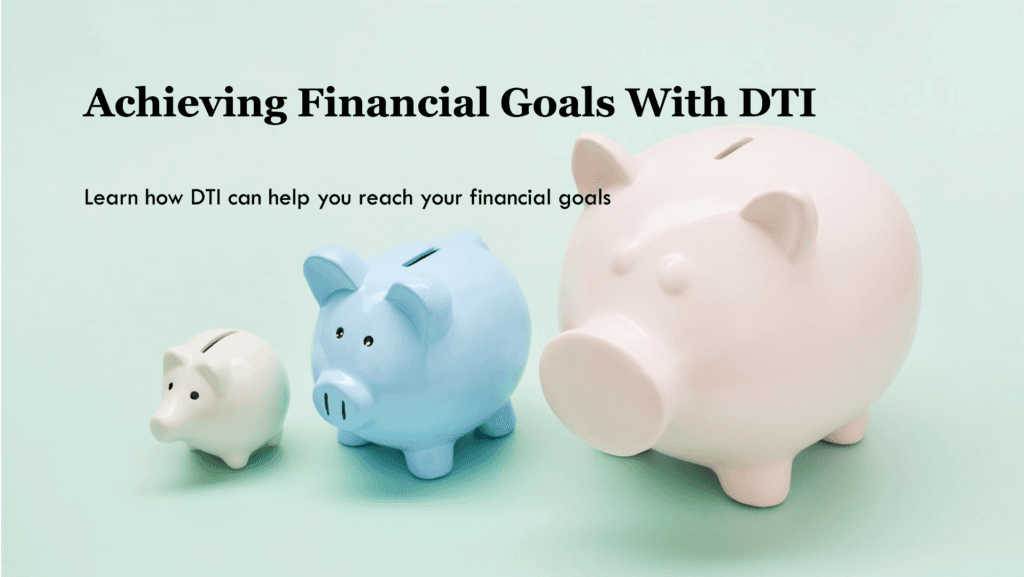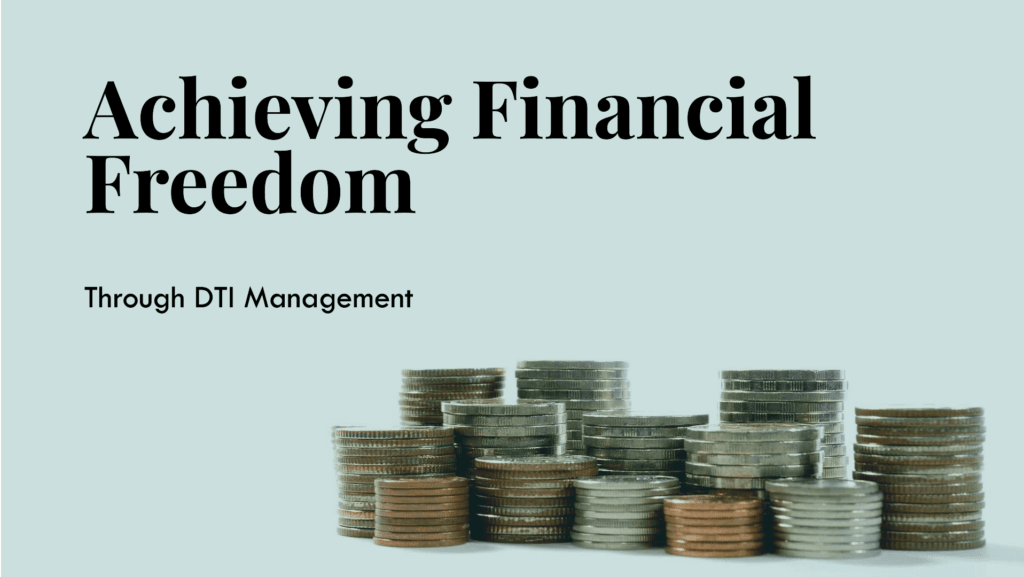In a world driven by innovation and informed decision-making, managing personal finances has never been more critical. At Technology Moment, we bridge the gap between technological advancements and practical solutions for everyday challenges. Our latest blog, “Financial Freedom with DTI Codes | Financial Advisor,” explores how mastering your Debt-to-Income (DTI) ratio can pave the way to achieving financial stability and independence.
Dive into actionable insights, expert advice, and real-world examples that will empower you to take control of your financial future with confidence. Whether you’re navigating loans, planning a big purchase, or simply striving for peace of mind, we’ve got the tools and knowledge to help you succeed. Stay informed, stay empowered, and embrace the journey to financial freedom.
Financial freedom is a goal that resonates with almost everyone. It’s that dream of living life on your terms, without the constant stress of bills, debts, or financial limitations holding you back. But as dreamy as it sounds, achieving financial freedom is not just about earning more money—it’s about managing what you already have in a way that aligns with your goals.
One crucial yet often overlooked factor in the journey to financial independence is understanding your Debt-to-Income (DTI) ratio. This simple yet powerful metric acts as a barometer of your financial health. It measures how much of your income is dedicated to paying off debts, and understanding it can be a game-changer for your financial stability.
Imagine your finances as a ship. If your income is the wind driving you forward, then your debt is the anchor that can slow you down. The DTI ratio helps you understand the balance between these two forces. Too much debt compared to your income can make it hard to move forward—whether you’re trying to buy a home, secure a loan, or save for retirement. This is where DTI codes step in to provide clarity and actionable insights.
By knowing your DTI ratio and learning to manage it effectively, you can make smarter financial decisions. It’s not just about crunching numbers; it’s about taking control of your financial future. Whether you’re aiming for a debt-free life or planning to invest in opportunities that generate wealth, understanding DTI is the first step in that direction.
In this guide, we’ll explore how DTI codes work, why they’re essential, and how you can use them to pave your path to financial freedom. Let’s break it down, step by step, so you can start building a solid foundation for your financial goals.
Table of Contents
Understanding DTI Codes
Debt-to-Income (DTI) codes are a crucial aspect of financial literacy, especially for those aiming to achieve financial freedom. To grasp their significance, let’s break down this concept into manageable pieces.
What is DTI?
The Debt-to-Income ratio (DTI) is a financial metric that compares your monthly debt payments to your monthly income. It’s expressed as a percentage and helps determine how much of your income is being allocated toward paying off debts.
Why DTI Matters for Financial Freedom
DTI is not just a number—it’s a financial health check-up. A low DTI indicates that your income significantly exceeds your debt obligations, signaling that you have more financial breathing room. Conversely, a high DTI suggests you may be overleveraged, making it harder to secure loans or investments and increasing financial stress.
Financial institutions heavily rely on DTI to evaluate creditworthiness. Whether you’re applying for a mortgage, car loan, or personal loan, lenders use your DTI ratio to assess your ability to repay. Maintaining a favorable DTI can help you unlock better financial opportunities and lower interest rates.
The Basics of Calculating DTI
Calculating your DTI is straightforward:
- Add up all monthly debt payments. Include expenses such as:
- Mortgage or rent
- Credit card payments
- Student loans
- Auto loans
- Any other recurring debts
- Divide the total by your gross monthly income.
- Multiply the result by 100. This gives you the DTI percentage.
For example:
- Monthly debts: $2,000
- Gross income: $6,000
- DTI = ($2,000 ÷ $6,000) × 100 = 33.33%
A DTI ratio below 36% is generally considered healthy, while anything above 43% may raise red flags for lenders.
Types of DTI Ratios
DTI can be further categorized into two types:
- Front-End DTI: Focuses solely on housing-related expenses, such as rent or mortgage payments, divided by your gross income. This is particularly relevant for potential homeowners.
- Back-End DTI: Includes all monthly debt payments, providing a comprehensive view of your financial obligations.
How DTI Codes Fit In
DTI codes are the guidelines or thresholds set by lenders and financial institutions to evaluate borrowers’ risk levels. These codes help streamline loan approvals and ensure that individuals are borrowing within their means. For example, a lender may have a policy that borrowers with a DTI above 50% are automatically disqualified for certain types of loans.
By understanding DTI codes, you can tailor your financial habits to align with industry standards, increasing your chances of loan approval and achieving long-term financial stability.
Why DTI is a Roadmap to Financial Freedom
Think of DTI as a GPS for your finances. By regularly monitoring and managing your DTI ratio, you can identify areas of improvement, set realistic financial goals, and track progress toward achieving financial independence. DTI codes act as guideposts, ensuring that you stay on the path to success without veering into financial instability.
How DTI Affects Financial Goals
Your Debt-to-Income (DTI) ratio plays a pivotal role in shaping your financial goals and the strategies needed to achieve them. A lower DTI suggests greater financial stability, while a higher DTI can signal financial strain. Here’s a detailed look at how DTI impacts key financial goals:

Homeownership and DTI
Buying a home is one of the most significant financial milestones, and your DTI ratio is a critical factor in the mortgage approval process. Lenders assess your DTI to determine if you can manage monthly mortgage payments alongside existing debts.
- Impact on Mortgage Eligibility:
Most lenders prefer a DTI below 43% for mortgage approval. A higher DTI might lead to loan rejections or stricter terms. - Influence on Interest Rates:
A low DTI can secure you favorable interest rates, reducing long-term costs and making homeownership more affordable. - Setting Realistic Budgets:
Understanding your DTI helps you set a realistic home-buying budget, ensuring you don’t overextend financially.
Loan Approval and Interest Rates
Whether it’s a car loan, personal loan, or business loan, lenders closely scrutinize your DTI ratio to gauge creditworthiness.
- Approval Likelihood:
A low DTI shows lenders you have a manageable debt load, increasing your chances of approval. Conversely, a high DTI may raise red flags about your ability to repay. - Interest Rate Implications:
Borrowers with lower DTIs are typically offered lower interest rates, which can save significant amounts over the life of the loan. - Loan Amount Limitations:
Lenders may cap the amount you can borrow if your DTI is on the higher side, limiting your financial flexibility.
Managing Debt Responsibly
Your DTI ratio also acts as a compass for personal debt management. If you’re working towards goals like becoming debt-free, building savings, or investing, your DTI provides a measurable way to track progress.
- Assessing Debt Levels:
A high DTI indicates you might be over-leveraged, prompting you to prioritize debt repayment to regain control. - Planning for Future Goals:
A lower DTI opens up opportunities for pursuing goals like higher education, entrepreneurship, or early retirement without financial stress. - Avoiding Financial Pitfalls:
Regularly monitoring your DTI ensures you don’t unintentionally fall into excessive debt, which can derail financial plans.
Strategies to Improve Your DTI Ratio
Improving your Debt-to-Income (DTI) ratio is essential for achieving financial stability and opening doors to opportunities like loan approvals, lower interest rates, and greater financial freedom. A better DTI ratio signifies a healthier balance between your debt and income, which can make a huge difference in your financial journey. Let’s break down the most effective strategies to improve your DTI ratio:
1. Increasing Income Streams
One of the most straightforward ways to improve your DTI ratio is by boosting your income. Here’s how you can do it:
- Take on a Side Hustle: Freelancing, gig work, or selling skills online can provide additional income streams. Platforms like Upwork, Etsy, or Uber can help you monetize your skills or assets.
- Negotiate a Raise: If you’re excelling at your current job, consider negotiating a pay increase. Highlight your achievements and market value during discussions with your employer.
- Invest in Skills Development: Upskilling in high-demand areas can lead to better-paying job opportunities. Certifications, training, or degrees in fields like tech, finance, or healthcare are worth exploring.
2. Reducing Monthly Debt Obligations
Lowering your debt is critical for achieving a better DTI ratio. Here’s how you can tackle this:
- Prioritize High-Interest Debts: Use methods like the debt avalanche (paying off high-interest debts first) or debt snowball (paying smaller debts first to build momentum).
- Consolidate Loans: If you have multiple debts, consolidating them into one loan with a lower interest rate can reduce your monthly payments.
- Negotiate with Creditors: Sometimes, creditors may agree to lower interest rates or monthly payments if you communicate proactively.
3. Budgeting and Financial Planning
A solid budget can provide a clear roadmap to control your spending and improve your DTI ratio:
- Track Your Expenses: Use apps like Mint or YNAB (You Need A Budget) to monitor and categorize your spending. Identify areas where you can cut back.
- Create a Realistic Budget: Prioritize essential expenses like housing, utilities, and groceries while allocating a portion of your income toward debt repayment and savings.
- Set Financial Goals: Clear, actionable goals—such as paying off a specific debt or achieving a target DTI ratio—can keep you motivated.
4. Avoid Accumulating New Debt
Taking on new loans or increasing credit card balances can worsen your DTI ratio. Here’s how to avoid this trap:
- Limit Credit Card Use: Use cash or debit cards for discretionary spending to avoid adding to your debt.
- Say No to Impulse Purchases: Adopt mindful spending habits. Ask yourself whether a purchase aligns with your financial goals before committing to it.
- Pause Major Purchases: If possible, delay large expenses until your DTI ratio is healthier.
5. Refinance Existing Loans
- Lower Monthly Payments: By refinancing, you can reduce your monthly obligations, improving your DTI ratio.
- Extend Loan Terms: While this can increase the total interest paid over time, it may make immediate monthly payments more manageable.
6. Build an Emergency Fund
Unexpected expenses can derail your debt repayment efforts. Having an emergency fund in place ensures you won’t rely on credit cards or loans during financial emergencies. Start with small, achievable goals, such as saving one month’s worth of expenses, and build up over time.
7. Regularly Review Your Financial Situation
Improving your DTI ratio is a dynamic process that requires regular monitoring and adjustments:
- Check Your Progress Monthly: Review your DTI ratio and adjust your strategies as needed.
- Celebrate Milestones: Paying off a debt or achieving a lower DTI ratio are wins worth celebrating. Positive reinforcement can keep you on track.
The Role of Financial Advisors
Financial advisors play a pivotal role in helping individuals and families navigate the complexities of managing their Debt-to-Income (DTI) ratio. By providing expert guidance, tools, and strategies, they empower clients to make informed decisions that lead to better financial outcomes. Here’s a detailed look at how financial advisors can assist in managing DTI effectively and achieving long-term financial freedom:
How Advisors Help with DTI Management
- Personalized Financial Analysis
Financial advisors begin by assessing your financial situation comprehensively. They analyze your income, expenses, debt obligations, and credit profile to calculate your current DTI ratio. This detailed analysis helps in identifying specific areas that need improvement. - Goal Setting and Planning
Advisors work closely with you to set realistic financial goals. Whether it’s buying a home, consolidating debt, or improving your credit score, they create a roadmap tailored to your needs. This plan focuses on lowering your DTI ratio while aligning with your broader financial objectives. - Debt Reduction Strategies
One of the main challenges in improving DTI is managing debt. Financial advisors provide actionable strategies to reduce high-interest loans, negotiate better repayment terms, and prioritize debt payments effectively. Their expertise ensures that every dollar you spend on debt repayment is optimized. - Income Optimization Guidance
Financial advisors also explore ways to increase your income. Whether it’s identifying side hustle opportunities, negotiating salary raises, or investing in income-generating assets, they provide creative solutions to boost your earnings and improve your DTI ratio.
Tools and Resources Available
- Budgeting Tools
Advisors often introduce clients to sophisticated budgeting tools and apps. These resources track your expenses, identify unnecessary spending, and ensure you stay within a budget that supports your financial goals. - Debt Consolidation Options
Financial advisors can recommend debt consolidation programs or balance transfer credit cards that simplify repayment and potentially lower monthly obligations. This reduces the burden on your DTI ratio. - Educational Resources
Many advisors offer workshops, webinars, and one-on-one coaching sessions to educate clients about financial literacy. This knowledge empowers you to make smarter decisions about debt and income management.
Long-Term Benefits of Professional Advice
- Achieving Financial Freedom Faster
With an advisor’s guidance, you can implement proven strategies to lower your DTI ratio quickly and efficiently, putting you on a faster track to financial freedom. - Minimizing Stress and Uncertainty
Advisors act as a calming presence, providing clarity and confidence in your financial decisions. - Building a Robust Financial Future
Beyond DTI management, financial advisors help clients establish emergency funds, invest in retirement accounts, and plan for significant life events, ensuring a solid foundation for long-term stability.
Common Mistakes to Avoid in Managing DTI
When it comes to achieving financial freedom, managing your Debt-to-Income (DTI) ratio is critical. Many people make mistakes that can negatively affect their financial journey, leading to higher debt, higher interest rates, and delayed financial goals. Here are some common mistakes to avoid when working to improve or manage your DTI ratio:
1. Ignoring Your DTI Ratio
One of the biggest mistakes people make is simply ignoring their DTI ratio. While it may seem like a number on paper, your DTI ratio directly impacts your ability to get approved for loans, mortgages, and other credit opportunities. A high DTI ratio means you’re carrying a lot of debt relative to your income, which could raise red flags for lenders, affecting your ability to qualify for financial products with favorable terms.
Why it matters:
Not regularly checking your DTI ratio could mean you miss warning signs that you’re taking on too much debt or that your debt obligations are becoming unmanageable. Ignoring it could also result in higher interest rates on loans or rejection from potential creditors.
How to avoid it:
Track your DTI regularly by reviewing your income and debt obligations. Make it a part of your financial planning and adjust your spending habits or debt management strategies when necessary.
2. Overborrowing
Overborrowing is another common mistake that can significantly impact your DTI ratio. It’s easy to take on more debt than you can realistically manage, especially when lenders offer you credit lines, loans, or mortgages. While it may feel tempting to borrow more, this increases your debt obligations and raises your DTI, which may hinder your financial freedom.
Why it matters:
Overborrowing means that a larger percentage of your income is directed toward repaying debt, leaving you with less money to invest, save, or spend on other financial goals. A higher DTI ratio can make it more difficult to secure future loans and could hurt your credit score.
How to avoid it:
Be mindful of your borrowing capacity. Aim for loans and credit lines that fit comfortably within your ability to repay, maintaining a healthy DTI ratio.
3. Delaying Debt Repayment
Delaying debt repayment may seem like an easy way to avoid dealing with financial obligations, but it can have significant consequences on your DTI ratio. By putting off paying down your debt, you’re letting your obligations grow and accumulate more interest, further increasing your overall debt. This can cause your DTI ratio to climb, reducing your chances of achieving financial freedom.
Why it matters:
The longer you delay debt repayment, the more interest you accrue, and the harder it becomes to improve your DTI. Additionally, some debts (like credit card balances) can compound quickly, making it more difficult to get ahead financially.
How to avoid it:
Stay on top of your debt payments. If you’re struggling, prioritize high-interest debt first, and explore options like consolidating loans or negotiating with creditors for better terms. Always aim to pay off debt as quickly as possible to keep your DTI ratio in check.
4. Not Considering the Impact of Fixed Expenses
Many people focus primarily on their monthly loan repayments when calculating their DTI ratio but fail to consider other significant monthly expenses, such as utilities, insurance premiums, or child support payments. These fixed costs still affect your financial picture, as they take up part of your income, indirectly impacting your DTI ratio.
Why it matters:
Underestimating the role of these expenses can lead to a skewed view of your financial health. Even if you’re keeping up with loan repayments, failing to account for fixed expenses can lead to financial strain and missed opportunities for saving or investing.
How to avoid it:
When calculating your DTI ratio, include all fixed monthly expenses in your budget. This will give you a more accurate picture of your financial standing and help you make better decisions about taking on new debt.
5. Failing to Seek Professional Help
Lastly, one mistake people often make is not seeking help from financial advisors when needed. Managing your DTI ratio effectively can be complex, and trying to do it alone can lead to costly mistakes. A professional can offer guidance, resources, and strategies tailored to your situation, helping you avoid common pitfalls.
Why it matters:
Trying to navigate debt management on your own, especially without a full understanding of DTI codes and their implications, can be overwhelming and lead to suboptimal financial decisions. Financial advisors have the expertise to help you create a plan to reduce your debt, increase your income, and improve your financial outlook.
How to avoid it:
If you’re struggling with your DTI or financial planning, don’t hesitate to consult a financial advisor. They can help you assess your current situation, create a plan to reduce your debt, and optimize your DTI for long-term financial success.
Real-Life Examples of Financial Freedom Through DTI Management
Achieving financial freedom isn’t just a lofty goal for some; it’s a tangible reality for many who have successfully managed their Debt-to-Income (DTI) ratios. Let’s explore a few real-life examples of how individuals have used DTI management strategies to pave the way toward financial independence.

1. Sarah’s Journey to Homeownership
Sarah, a single mother in her early 30s, had always dreamed of owning a home but was stuck renting due to her high DTI ratio. She had a stable income from her job as a teacher, but she also had significant student loans and credit card debt, which kept her DTI ratio above 40%—a threshold that made mortgage lenders hesitant to approve her.
Determined to change her financial situation, Sarah sought the help of a financial advisor. Together, they devised a strategy to reduce her DTI. The first step was prioritizing her debts, focusing on high-interest credit cards. Sarah also worked on building up her savings to reduce the need for a large mortgage loan. Over the next two years, she diligently followed a strict budget and paid down her credit card debt, improving her DTI ratio to below 30%.
With her DTI now more favorable, Sarah was able to secure a mortgage at a reasonable interest rate and purchase her first home. This was a huge milestone in her journey to financial freedom, and it all began with understanding and improving her DTI ratio.
2. John and Lisa’s Path to Financial Independence
John and Lisa were a married couple with two kids and a combined annual income of $85,000. However, they had accumulated debt over the years, including car loans, credit card balances, and a personal loan for home repairs. Their DTI ratio had steadily climbed to 45%, leaving them with little room for savings or investments. They felt financially trapped, unable to build wealth or plan for their future effectively.
After a series of financial planning sessions with a trusted advisor, John and Lisa decided to take aggressive action. The first step was increasing their income by taking on side jobs. John worked weekends as a freelance consultant, while Lisa started a small online business. They also tackled their debt with a snowball method—paying off the smallest loans first and rolling those payments into larger debts.
Over the course of three years, their DTI ratio dropped to 30%, and they started seeing real progress toward their financial goals. They not only paid off all their consumer debt but also started investing in retirement accounts and building an emergency fund. With a lower DTI, John and Lisa were able to access better loan terms for investments and business growth, propelling them further on the road to financial independence.
3. Mark’s Debt-Free Retirement Plan
Mark, a 50-year-old man nearing retirement, had always been diligent about saving, but he had accumulated a significant amount of debt over the years due to business ventures and personal loans. With a DTI ratio hovering around 38%, Mark wasn’t sure if he would be able to retire comfortably, especially as his income was nearing its peak and he planned to stop working soon.
Mark consulted with a financial advisor who helped him develop a strategy to reduce his DTI before retirement. The advisor recommended consolidating his high-interest loans and setting up a more structured debt repayment plan. Mark was also encouraged to downsize his lifestyle, cutting unnecessary expenses to accelerate debt repayment.
Within two years, Mark’s DTI ratio dropped to 25%. With his improved financial situation, he was able to refinance his remaining debts to secure lower interest rates. This move freed up more of his income, allowing him to increase his retirement savings. By the time Mark retired at 60, he was debt-free and had a robust retirement fund, achieving the financial freedom he had long desired.
4. Emily’s Debt-Free Entrepreneurial Leap
Emily, a 28-year-old entrepreneur, had always been passionate about starting her own business. However, her dreams seemed out of reach due to a high DTI ratio. With a student loan, car payment, and some credit card debt, Emily’s DTI was close to 42%, which made it difficult for her to secure the necessary financing to launch her startup.
Instead of giving up, Emily took a proactive approach to reduce her DTI. She started by cutting back on her lifestyle—living with roommates to reduce rent expenses and eliminating unnecessary subscriptions. Emily also took on freelance writing jobs, significantly increasing her income and using the extra earnings to pay down her debt more aggressively.
Within a year, Emily’s DTI ratio dropped to 30%. With her improved financial profile, she was able to secure a small business loan at a competitive rate to fund her startup. Today, her business is thriving, and her DTI is well under 25%, giving her the freedom to reinvest in her company and continue growing her wealth.
Conclusion
Achieving financial freedom is a goal that many aspire to, but it requires dedication, discipline, and a clear understanding of how to manage finances effectively. One of the most critical components of this process is mastering your Debt-to-Income (DTI) ratio. Your DTI is not just a number—it’s a reflection of how much of your income goes toward paying off debt, and it plays a pivotal role in your ability to access loans, secure favorable interest rates, and ultimately maintain financial health.
In this article, we explored how DTI codes can significantly influence your path to financial freedom. We discussed how calculating your DTI ratio helps you understand where you stand financially, how it impacts your ability to take on new debt, and the ways it can help you assess whether you are over-leveraged.
But improving your DTI ratio is not just about crunching numbers. It’s about taking action—whether by reducing debt, increasing your income, or working with a financial advisor to develop a tailored strategy for managing finances. We also emphasized the importance of seeking professional guidance, especially when navigating complex financial decisions, as advisors can offer invaluable tools, insights, and a long-term perspective.
In conclusion, mastering your DTI ratio is a critical step toward achieving financial freedom. It provides the clarity needed to set realistic goals, make better financial decisions, and ultimately take control of your financial future. Whether you’re aiming to buy a home, invest in opportunities, or simply reduce financial stress, understanding and managing your DTI is key to getting there.
With a proactive approach, the right financial tools, and expert advice, you can build a strong financial foundation that leads to the freedom you’ve always wanted. So, start taking steps today to reduce your debt, boost your income, and improve your DTI ratio. Your future self will thank you.
FAQs
What is a good DTI ratio?
A “good” Debt-to-Income (DTI) ratio typically varies based on your financial goals and situation, but generally, a lower DTI is seen as better. Financial experts often recommend keeping your DTI below 36%. This means that your total monthly debt payments should not exceed 36% of your gross monthly income.
Within that range, 28-36% is considered manageable for most people. However, some lenders may allow higher DTIs for individuals with substantial assets or a strong credit history. A DTI of below 20% is ideal, signaling a strong financial standing with little to no debt. On the other hand, a DTI above 40% may raise red flags for lenders, as it indicates that a significant portion of your income is dedicated to repaying debt, making it harder to save or handle unforeseen expenses.
How often should I review my DTI ratio?
It’s essential to monitor your DTI ratio regularly, especially if you’re working towards specific financial goals such as homeownership, starting a business, or retiring early. Reviewing it at least quarterly is a good practice. During this time, you can assess whether your debt levels are rising or if your income has changed, which could affect your ratio. It’s especially important to review your DTI when applying for loans, mortgages, or credit cards. Financial advisors often recommend reviewing it more frequently during periods of significant life changes, such as getting a new job, starting a family, or making large purchases.
Can I achieve financial freedom with a high DTI ratio?
Achieving financial freedom with a high DTI ratio can be challenging, but it’s not impossible. A higher DTI indicates that a large portion of your income is going toward debt repayment, which can limit your ability to save and invest. Focus on reducing debt, increasing your income, and cutting unnecessary expenses. A combination of disciplined debt management and smarter financial planning can help you bring your DTI down over time. With patience and effort, it is possible to work towards financial freedom, even with a high DTI ratio, but it may take longer.
What tools can I use to track my DTI?
Tracking your DTI is relatively simple with the help of various online tools and apps. Many financial institutions provide calculators on their websites where you can input your income and monthly debt obligations to determine your DTI. You can also use personal finance apps like Mint, YNAB (You Need A Budget), or Personal Capital, which allow you to track all your income, expenses, and debts in one place. These tools automatically calculate your DTI and help you visualize your overall financial health. Regularly updating these apps will give you an accurate and real-time picture of where you stand.
Is hiring a financial advisor worth it for managing DTI?
Hiring a financial advisor can be incredibly valuable when managing your DTI, especially if you feel overwhelmed or are not sure where to start. A financial advisor can help you create a customized plan to reduce debt, increase savings, and improve your overall financial situation. They can also offer strategies to optimize your spending and offer long-term solutions for achieving financial freedom. For individuals with complex financial situations, such as high-income earners, business owners, or those with multiple debts, a financial advisor can provide personalized advice and support. While there is a cost associated with hiring an advisor, the value they bring through expert guidance can often lead to significant long-term financial improvements.














I appreciate the insights on DTI codes and their role in achieving financial freedom! It’s refreshing to see a financial advisor break down complex concepts into understandable terms. This information will definitely help many people reassess their financial strategies.
Great discussion on DTI codes! Your explanation really clarifies how they can impact our journey toward financial freedom. I would love to see more examples of how these codes have helped others in real-life scenarios.
Thank you for shedding light on the importance of DTI codes in personal finance! Your feedback-oriented approach makes it easier for individuals to grasp how managing debt-to-income ratios can lead to greater financial independence.
This is a valuable perspective on financial freedom through DTI codes! I think it would be helpful if you could include tips on how to improve one’s DTI ratio, as that seems like a crucial step towards achieving the goals you discussed.
I found your take on DTI codes very enlightening! As someone who is trying to achieve financial freedom, your feedback has given me new strategies to consider. It might also be beneficial to explore common pitfalls related to DTI management.